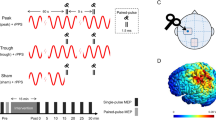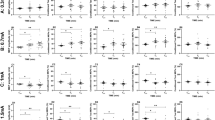Abstract
Corticospinal excitability can be increased by a transcranial magnetic stimulation (TMS) intervention that delivers repeated paired TMS pulses at an I (indirect)-wave interval of 1.5 ms. This is thought to target excitatory synaptic events by reinforcing facilitatory I-wave interaction, however, it remains to be determined what effect this intervention has on the various I-wave components. In the present study we compared I-wave facilitation curves over a range of inter-pulse intervals (IPIs) encompassing the first three I-waves, before and after 15 min of a paired-pulse TMS intervention with an IPI of 1.5 ms. The three peaks in the I-wave facilitation curves occurred at the same IPIs pre- and post-intervention (1.3, 2.5 and 4.3 ms). The facilitation curves were increased in amplitude for all three I-wave peaks post-intervention (mean increase 33%), and the mean increase across all IPIs correlated with the post-intervention increase in single-pulse MEP amplitude (r = 0.77). Modelling showed that the changes in the post-intervention curves were consistent with an increase in amplitude and broadening of the individual I-wave peaks. We conclude that an iTMS intervention with an IPI of 1.5 ms is able to target multiple I-waves. The findings are consistent with existing models of I-wave generation and suggest that the intervention increases the efficacy of synaptic events associated with the generation of descending I-wave volleys.






Similar content being viewed by others
References
Benwell NM, Mastaglia FL, Thickbroom GW (2006) Paired-pulse rTMS at trans-synaptic intervals increases corticomotor excitability and reduces the rate of force loss during a fatiguing exercise of the hand. Exp Brain Res 175:626–632
Di Lazzaro V, Oliviero A, Berardelli A, Mazzone P, Insola A, Pilato F, Saturno E, Dileone M, Tonali PA, Rothwell JC (2002) Direct demonstration of the effects of repetitive transcranial magnetic stimulation on the excitability of the human motor cortex. Exp Brain Res 144:549–553
Di Lazzaro V, Thickbroom GW, Pilato F, Profice P, Dileone M, Mazzone P, Insola A, Ranieri F, Tonali PA, Rothwell JC (2007) Direct demonstration of the effects of repetitive paired-pulse transcranial magnetic stimulation at I-wave periodicity. Clin Neurophysiol 118:1193–1197
Fitzgerald PB, Fountain S, Daskalakis ZJ (2006) A comprehensive review of the effects of rTMS on motor cortical excitability and inhibition. Clin Neurophysiol 117:2584–2596
Hamada M, Hanajima R, Terao Y, Arai N, Furubayashi T, Inomata-Terada S, Yugeta A, Matsumoto H, Shirota Y, Ugawa Y (2007) Origin of facilitation in repetitive, 1.5 ms interval, paired pulse transcranial magnetic stimulation (rPPS) of the human motor cortex. Clin Neurophysiol 118:1596–1601
Hanajima R, Ugawa Y, Terao Y, Enomoto H, Shiio Y, Mochizuki H, Furubayashi T, Uesugi H, Iwata NK, Kanazawa I (2002) Mechanisms of intracortical I-wave facilitation elicited with paired-pulse magnetic stimulation in humans. J Physiol 538:253–261
Pascual-Leone A, Valls-Sole J, Wassermann EM, Hallett M (1994) Responses to rapid-rate transcranial magnetic stimulation of the human motor cortex. Brain 117(part 4):847–858
Quartarone A, Bagnato S, Rizzo V, Morgante F, Sant’angelo A, Battaglia F, Messina C, Siebner HR, Girlanda P (2005) Distinct changes in cortical and spinal excitability following high-frequency repetitive TMS to the human motor cortex. Exp Brain Res 161:114–124
Ridding MC, Taylor JL (2001) Mechanisms of motor-evoked potential facilitation following prolonged dual peripheral and central stimulation in humans. J Physiol 537:623–631
Rothwell J (2005) Transcranial Electrical and Magnetic Stimulation of the Brain: Basic Physiological Mechanisms. In: Hallett M, Chokroverty S (eds) Magnetic stimulation in clinical neurophysiology. Elsevier Butterworth Heinemann, Philadelphia, pp 43–60
Rothwell JC, Thompson PD, Day BL, Boyd S, Marsden CD (1991) Stimulation of the human motor cortex through the scalp. Exp Physiol 76:159–200
Thickbroom GW (2007) Transcranial magnetic stimulation and synaptic plasticity: experimental framework and human models. Exp Brain Res 180:583–593
Thickbroom GW, Byrnes ML, Edwards DJ, Mastaglia FL (2006) Repetitive paired-pulse TMS at I-wave periodicity markedly increases corticospinal excitability: a new technique for modulating synaptic plasticity. Clin Neurophysiol 117:61–66
Tokimura H, Ridding MC, Tokimura Y, Amassian VE, Rothwell JC (1996) Short latency facilitation between pairs of threshold magnetic stimuli applied to human motor cortex. Electroencephalogr Clin Neurophysiol 101:263–272
Wassermann EM, Grafman J, Berry C, Hollnagel C, Wild K, Clark K, Hallett M (1996) Use and safety of a new repetitive transcranial magnetic stimulator. Electroencephalogr Clin Neurophysiol 101:412–417
Ziemann U, Rothwell JC (2000) I-waves in motor cortex. J Clin Neurophysiol 17:397–405
Ziemann U, Tergau F, Wassermann EM, Wischer S, Hildebrandt J, Paulus W (1998) Demonstration of facilitatory I wave interaction in the human motor cortex by paired transcranial magnetic stimulation. J Physiol 511(Pt 1):181–190
Acknowledgments
Professor U. Ziemann, University of Frankfurt, is thanked for helpful comments. This work was supported by the Western Australian Neurotrauma Research Program.
Author information
Authors and Affiliations
Corresponding author
Rights and permissions
About this article
Cite this article
Cash, R.F.H., Benwell, N.M., Murray, K. et al. Neuromodulation by paired-pulse TMS at an I-wave interval facilitates multiple I-waves. Exp Brain Res 193, 1–7 (2009). https://doi.org/10.1007/s00221-008-1590-7
Received:
Accepted:
Published:
Issue Date:
DOI: https://doi.org/10.1007/s00221-008-1590-7




